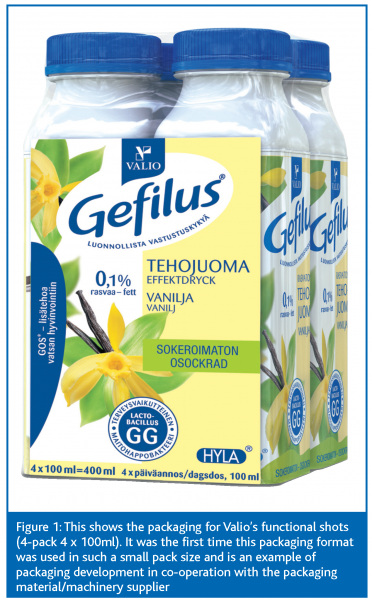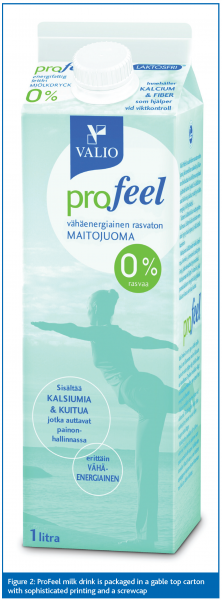Insights from Finland’s top dairy
- Like
- Digg
- Del
- Tumblr
- VKontakte
- Buffer
- Love This
- Odnoklassniki
- Meneame
- Blogger
- Amazon
- Yahoo Mail
- Gmail
- AOL
- Newsvine
- HackerNews
- Evernote
- MySpace
- Mail.ru
- Viadeo
- Line
- Comments
- Yummly
- SMS
- Viber
- Telegram
- Subscribe
- Skype
- Facebook Messenger
- Kakao
- LiveJournal
- Yammer
- Edgar
- Fintel
- Mix
- Instapaper
- Copy Link
Posted: 11 August 2006 | Tanja Virtanen-Leppä, Packaging Development Manager at Valio Ltd | No comments yet
With the multitude of products on today’s supermarket shelves, there is increasing pressure among manufacturers to set themselves apart in the eyes of the consumer. Packaging has the crucial task of making that all-important first impression, which can mean the difference between a sale or not. It must be attractive and succinctly convey the product’s message; as well as provide the necessary hygiene and safety functions whilst being easy to operate. But how does a food producer achieve the ideal packaging for its products? New Food spoke with Tanja Virtanen-Leppä, Packaging Development Manager at Valio Ltd to find out their packaging requirements and how they manage the task.
With the multitude of products on today’s supermarket shelves, there is increasing pressure among manufacturers to set themselves apart in the eyes of the consumer. Packaging has the crucial task of making that all-important first impression, which can mean the difference between a sale or not. It must be attractive and succinctly convey the product’s message; as well as provide the necessary hygiene and safety functions whilst being easy to operate. But how does a food producer achieve the ideal packaging for its products? New Food spoke with Tanja Virtanen-Leppä, Packaging Development Manager at Valio Ltd to find out their packaging requirements and how they manage the task.
With the multitude of products on today’s supermarket shelves, there is increasing pressure among manufacturers to set themselves apart in the eyes of the consumer. Packaging has the crucial task of making that all-important first impression, which can mean the difference between a sale or not. It must be attractive and succinctly convey the product’s message; as well as provide the necessary hygiene and safety functions whilst being easy to operate. But how does a food producer achieve the ideal packaging for its products? New Food spoke with Tanja Virtanen-Leppä, Packaging Development Manager at Valio Ltd to find out their packaging requirements and how they manage the task.
Founded in 1905, Valio Ltd is Finland’s largest dairy – and indeed, food – company, with a net turnover of EUR 1.4 billion in 2005. Perhaps because of this, Valio is also the country’s biggest packaging user, getting through approximately 45 000 tonnes of packaging material per year. But does Valio simply buy in ready-assembled packaging, or develop its own?
“Of course we develop our own packaging,” exclaims Virtanen-Leppä, “this is carried out with the packaging suppliers, especially when the packaging machine has to be developed together with the packaging” (Figure 1) Working with supplier companies is a common practice in the food industry, with companies realising the benefits of working with equipment that is specifically adapted to suit their needs and, it seems, Valio is no exception. “Valio uses gable top cartons Tetra Rex and Pure Pak as well as other carton based liquid packaging such as Tetra Brik and Tetra Top ‘carton bottles’,” continues Virtanen-Leppä. “Rigid thin wall plastic packaging (such as tubs and other containers), flexible films and some bag-in-box packaging is also used.” The former types are clearly the most prevalent and this reflects the current trend in the region: “The amount of carton based consumer packaging is high in Finland and other Nordic countries,” comments Tanja (Figure 2).
But what properties does Tanja Virtanen-Leppä look for in Valio’s packaging?
“Packaging must be suitable for the product category and it must fulfill the necessary functional requirements,” she explains. “Some categories have special requirements, such as to be an oxygen barrier. Packaging should also be suitable for existing packaging lines – any modification of the line should be easy. If a new packaging line is needed, it should be suitable for more than one product in order to use packaging capacity efficiently.” Obviously, it is also not cost-effective to implement an entirely new line for the packaging of a single product; automation is a significant investment and must be justified wherever possible. “Valio has a highly automated warehouse system and there are some special requirements for the packaging to fit the system,” says Virtanen-Leppä. “Customer orders are picked by robots and distributed to the retailers directly” – and not to retailer distribution centres, as is more usual. This helps to ensure the freshness of products which is especially important with fresh dairy products which account for 41.5 per cent of the Group’s net turnover.
Have consideration
Valio expects many things of its packaging, least of which it seems, is to merely package the product. “Packaging should promote brand” states Virtanen-Leppä. “Differentiation is more important in some product categories than in others. Consumer packaging should be convenient and easy to dispose of, but packaging should also meet the retailer’s requirements and should fit into Valio’s logistic system.” There are clearly many demands on product packaging, which in turn means more demands on packaging development! For this reason, the relationship between company and packaging supplier is an important one that relies on clear communication and understanding of each party’s requirements and capabilities. But is this a reality?
“Tough competition, high rotation and shorter product life cycles usually lead to the need for quick reaction,” considers Tanja. “Quick reaction would require more cost efficient pricing for smaller order sizes.” This is clearly a significant factor for all food and beverage processors, whether they depend on ordering larger quantities of packaging material or not. Economies of scale suggest that larger manufacturers are better off than SMEs in this regard, yet they pay the price of not being able to react fast enough when needed.
Tanja also points out that “the development process for new packaging could be faster”. But how will packaging itself develop in the future?
“Packaging is increasingly considered to be an integral part of marketing,” so this aspect of packaging’s role will no doubt be enhanced. Aside from aesthetics, however, convenience is expected to continue to be important. That which is important to consumers, is ultimately important to food companies and for as long as there is demand for easy-to-use packaging, the trend will continue. “Convenience is still going strong,” confirms Virtanen-Leppä.




Issue
Related topics
Packaging & Labelling, Quality analysis & quality control (QA/QC)









